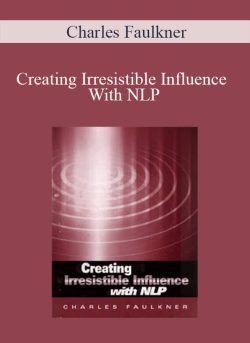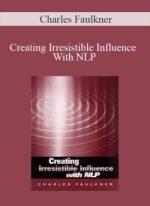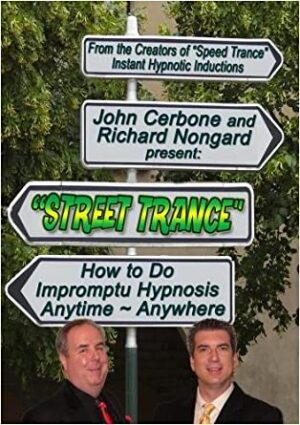Charles Faulkner – Creating Irresistible Influence With NLPThis is Workbook Experience “meaningful influence” and learn how to use it to get what you really want by helping others to get what they really want You will learn how to influence more effectively and obtain more of what you really want. In Creating Irresistible Influence with NLP, you’ll learn: The crucial difference between influence and manipulation. How to hear (and see) what people really want. The five levels of the Pyramid of Influence. The Five Life Purposes that drive all of us. With Creating Irresistible Influence with NLP, you can open up an exciting new dimension in your life. One that can make life a more fulfilling adventure than you have ever imagined. All you have to do is apply this knowledge and make meaningful influence the magic that transforms your life!About Author:Charles Faulkner, (born 12 January 1952), is an American, currently living in England, who is a master NLP (Neuro-linguistic Programming) practitioner and trainer, life coach, motivational speaker, trader and author. Faulkner began his career studying linguistics at Northwestern University while counseling at a crisis center. Having discovered NLP, a method he surmised to be a more advanced way of changing human behavior, he abandoned his course of study and became a licensed NLP practitioner.Most notably, Faulkner developed Neuro-linguistic Programming methods of modeling excellence in the world of finance. He has authored a number of books and audio tapes, of which the most well-known audio is “NLP:The New Technology of Achievement.” Faulkner is profiled in the book The New Market Wizards by Jack D. Schwager. Charles has pioneered methods for accelerated language learning, as well as medical and financial decision-making. He is particularly well-known for his work with futures traders and his research on the role of metaphor in communication and behavior.After training with all of NLP’s co-founders, Charles Faulkner achieved mastery of Neuro-linguistic Programming. By blending his expertise in Ericksonian hypnosis (the foundation for NLP) with a wide array of cognitive-linguistic disciplines, as well as the Rogerian approach and Gestalt therapy, Charles Faulkner developed a unique system of modeling which he subsequently contributed to the field of NLP.[10] In particular, Faulkner applies his modeling expertise to develop success strategies, taught internationally.Charles Faulkner has given instruction at most of the major NLP training institutes, in both the Practitioner and Master Practitioner programs. In the mid-to-late 80’s, Faulkner was involved in learning and mapping NLP’s early models such as Sub-modalities, Belief change, Sleight-of-mouth, and the Imperative Self. In 1986 and 1987, he was editor of The NLP Connection, the journal for the National Association of NLP. During the two years that followed, he served as Executive Director of NLP Comprehensive.As of 2008, he has authored and co-authored 10 books (see Published works), one of which is entitled NLP: The New Technology of Achievement, the number one selling NLP book on Amazon.com.Neurolinguistic ProgrammingEarly NLP ModelsFaulkner’s numerous contributions to the field of NLP began in 1984 with his modeling of Accelerated Learning, to pioneer more efficient and effective learning strategies. He taught this model together with NLP, to a group of teachers in Japan that same year. The result of this work was the founding of Learning How to Learn. Upon returning to the U.S. in 1985, he modeled the Metaphors of Identity.[12] This model states that an individual’s strategies and behavior patterns are informed by deeply structured metaphors for life, self, desired outcomes and challenges. By adopting new metaphors, an individual can create new pathways to transformation.The academic research of cognitive linguists George Lakoff and Mark Johnson and Faulkner’s experience with Metaphors support his hypothesis that cognitive processes are mostly metaphoric, and unconscious. Hence, conscious desires with functional qualities have parallel metaphors that sustain them. Twenty years later, Faulkner would write about this phenomenon in a two-part article entitled “Outcomes, Decisions & ‘Levels’ of Meaning.”[12] In the years that followed, Faulkner continued to develop additional models, such as Physician Decision Strategies in 1986, Futures Trading in 1987, and finally System Structure (a simultaneous strategies model) in 1990.Expert ModelerIn the 1990s, Faulkner honed his expertise as a modeler. He completed Perpetual Cybernetics, which differentiated the seven “worlds of subjective experience” that NLP uses as a basis for its presuppositions and techniques. In 1993, together with golf pro Mark Staples, he co-founded E.P.I.C Golf by modeling the internal and external behavior patterns of outstanding golfers. Later that same year, Faulkner co-authored and starred in the video NLP in Action[10] and in 1994 he co-authored a book with Robert McDonald, entitled Success Mastery with NLP, based on his work modeling ‘flow states‘ and the behavior of exceptional achievers. He continued to develop Perpetual Cybernetics in conjunction with his Living Myths & Metaphors work to arrive at one, single, unified model: the Metaphors of Perception. This work subsequently spawned several more models, including: Worlds Within a Word, Rhythms of Time (1995), and Meta-Patterns (1996).In 2003, Faulkner co-authored with Steve Andreas to write NLP: The New Technology of Achievement. In the book, they write, “Lengthy struggle without success is a sign that what we’re doing isn’t working. It’s time to do something else, anything else. It’s time to realize that pain, struggle, suffering and waiting are signs that it’s time for another approach….“ The following year, he attended the NLP Conference and Festival at the University of Bristol, England. There Faulkner presented “Awakening to the Social – An Introduction to Irresistible Influence.” The following year he presented “Expository Cartography,” an introduction to advanced mind mapping techniques that could be used to disengage habitual biases and systematically enrich any model including the more complex ones such as the four-quadrant model of Ken Wilber. In 2006 at the NLP Conference in London, he presented “Training is for Dogs and Horses”, a bold challenge to the limiting approach in which NLP had previously been taught. In September, 2007 Faulkner lectured at the London School of Economics to The Society for Organisational Learning(SOL-UK).Applications in Stock TradingFaulkner became a futures trader in the early 90’s as a way to apply his NLP-based models for peak performance. He encouraged fellow traders who were breaking into the industry to use positive statements when journaling. Otherwise, a trader may wind up unconsciously setting in negative trading patterns. He said in a Futures (magazine) article, “When you recall something, you reinforce it.“[16] He is interviewed at length about his studies of futures traders in numerous books including: The New Market Wizards (1992), by Jack Schwager; The Outer Game of Trading (1994), by Robert Koppel & Howard Abell; and The Intuitive Trader (1996), by Robert Koppel;[9] and Trend Following (2004), by Michael Covel.[8] Three years later, Faulkner contributed a forward to the paperback edition of Trend Following.“The Intuitive Trader”In Chapter Five of The Intuitive Trader, by Robert Koppel, Charles Faulkner shares his insights on how to develop the intuition needed to be a successful trader. He defines intuition as “getting a solution and not knowing how you got there” and “an insight into something that’s a result from your experience with it.” In other words, developed through expertise, intuition can be rephrased as an “educated inference.” Faulkner identifies four barriers to identifying and trusting a true intuitive impulse: lack of awareness in the subtleties of emotions, including those caused by uncertainty; self-imposed limitations of trying to predict market moves; acting on mistaken intuitions, or “cognitive illusions;” and finally, being driven by fear or greed.[19] On the other hand, a successful intuitive trader has built his confidence as a result of a developed awareness of “subtle inner signals.” Bandler and Grinder–the founders of NLP–discovered early on that these inner signals consist of thoughts that are primarily sensory in nature. In fact, all thoughts, conscious and subconscious, arise as unique combinations of an individual’s five senses. Conscious thinking will utilize a person’s more developed senses; meanwhile, intuitive thought uses a person’s least developed senses.Faulkner recommends that a new trader keep a dated journal of thoughts, feelings, ideas and insights related to the market. In time, the trader will notice certain patterns of how, when and where he receives intuitions. Moreover, a trader can see what happens when he follows an intuition, and–interestingly enough–what happens when he purposely makes a decision that goes counter to his intuition. Over time, having a passion for trading and diligently recording experiences will help a trader develop the awareness needed to trust those intuitive “leaps.” However, succeeding at trading is not without its requisite legwork which, according to Faulkner, lies in five key areas: market indicators, trading strategies and money management, emotional management, successful and supportive belief systems, and a winning “metaphoric mindset.” Finally, Koppel quotes The Outer Game of Trading, in which Faulkner briefly explores the dynamics of confidence and fear.Delivery Method– After your purchase, you’ll see a View your orders link which goes to the Downloads page. Here, you can download all the files associated with your order.– Downloads are available once your payment is confirmed, we’ll also send you a download notification email separate from any transaction notification emails you receive from Forimc.me.– Since it is a digital copy, our suggestion is to download and save it to your hard drive. In case the link is broken for any reason, please contact us and we will resend the new download link.– If you cannot find the download link, please don’t worry about that. We will update and notify you as soon as possible at 8:00 AM – 8:00 PM (UTC+8).Thank You For Shopping With Us! Reviews There are no reviews yet.Be the first to review “Charles Faulkner – Creating Irresistible Influence With NLP” Cancel replyYour rating *Rate…PerfectGoodAverageNot that badVery poorYour review *Name *Email *Δ
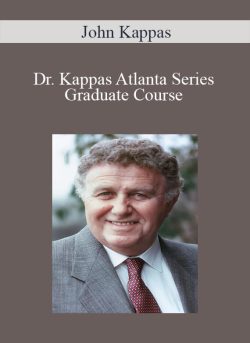 John Kappas – Dr. Kappas Atlanta Series – Graduate Course
₹18,094.00
John Kappas – Dr. Kappas Atlanta Series – Graduate Course
₹18,094.00
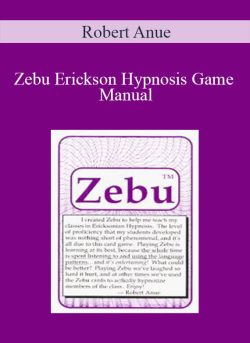 Robert Anue – Zebu Erickson Hypnosis Game Manual
₹1,992.00
Robert Anue – Zebu Erickson Hypnosis Game Manual
₹1,992.00
Charles Faulkner – Creating Irresistible Influence With NLP
₹1,992.00

